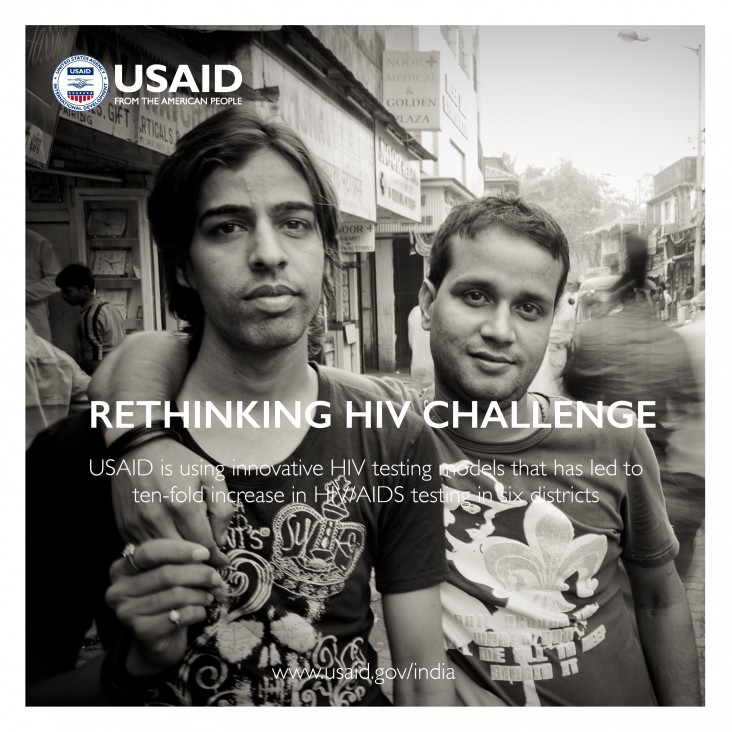India
- History
- Our Work
- Transforming Development Through Innovation & Partnership
- U.S.-India Triangular Cooperation
- Partnership for Energy Access and Security
- Partnership for Sustainable Forests in India
- Partnerships for Health
- Partnership for Education
- Partnership for Water Sanitation and Hygiene (WASH)
- Partnership for Food Security
- Partnership for Gender Equality
- Investing in Afghanistan
- Foreign Assistance Data
- Newsroom
- Newsletters and Fact Sheets
- Speeches
- Resources For Implementing Partners (RFIP)
- Careers
- Partnership Opportunities
- Success Stories
Speeches Shim

USAID — working through the President’s Emergency Plan for AIDS Relief (PEPFAR) — partners with the Government of India to strengthen the national HIV/AIDS program to accelerate and achieve epidemic control.
Building on decades of experience promoting an effective health system in India, USAID supports the National AIDS Control Plan (NACP) for prevention, care, and treatment programs for people living with HIV/AIDS. The combined efforts of USAID, the Government of India (GOI) and other partners resulted in a reduction of new HIV infections by 66 percent since 2000, and today more than one million people living with AIDS are currently on antiretroviral therapy. “Targeted interventions based on close collaboration with and empowerment of communities and civil society helped deliver key life-saving services to the affected population,“ Health Minister J.P. Nadda said in his address to the U.N. General Assembly in June 2016. Drawing on global evidence about effective HIV/AIDS care, treatment, and prevention methods, USAID supports the NACP to adopt cost-effective and evidence-based practices. The GOI supports nearly 80 percent of the total funding for HIV/AIDS programs nationally—an element essential to sustaining this vitally important work.
USAID/INDIA PROGRAMS
SHARED RESPONSIBILITY: The Government’s National AIDS Control Organization (NACO) and PEPFAR share the belief that the first step to ending the epidemic is accurate and timely testing to identify at least 90% of persons living with HIV. USAID’s programs work with NACO to deliver focused prevention, care, and support interventions in select districts with a high burden of HIV, which will have a direct impact on India achieving an AIDS-free generation.
SAVING LIVES: Across India, non-government organizations (NGOs) provide support for high-risk populations, including female sex workers, men who have sex with men, people who inject drugs, and transgender people. In addition to raising awareness, the NGOs provide testing, counseling, and referral for treatment. Technical support from national and international NGOs help strengthen the HIV/AIDS sector, engage at the higher level for policy adoption and implementation, and identify and address service gaps such as individuals who drop out of programs between testing and treatment.
SMART INVESTMENTS: To achieve an AIDS-free generation, USAID is targetting efforts to reach and support those populations at greatest risk and most urgently needing services. These are:
-
Orphans and Vulnerable Children: India has seven million children with at least one parent living with HIV and 1.5 million children orphaned due to HIV. Using a family-based and child-focused approach, USAID links HIV/AIDS-affected children to appropriate services. USAID focuses its interventions on children of key population most in need of these services.
-
TB/HIV: In India, tuberculosis (TB) is a leading cause of death in people living with HIV. Testing all persons living with HIV for TB, and vice versa, is essential to provide appropriate care and treatment. USAID initiated the first large-scale pilot to diagnose TB among people living with HIV in five states in India, which included a daily treatment regimen for those coinfected with TB and HIV. This led the national program to pilot daily treatment for all TB patients in 100 districts in India. USAID is working to ensure all TB patients are tested for HIV, including scaling up HIV/TB coordination mechanisms in priority states.
| India HIV/AIDS Indicators |
| Adult Prevalence 0.26% |
| People Living with HIV/AIDS 2.12 million |
| Annual New HIV Infections 86,000 |
| No. of people on treatment 1,285,880 |


Comment
Make a general inquiry or suggest an improvement.